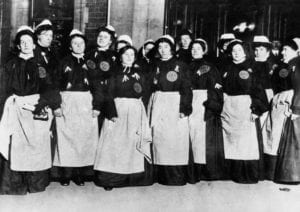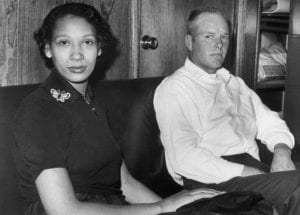
Conservative Commentator Rush Limbaugh
This is an update to an article I published four years ago.
The progress toward social liberalism may have been impeded since Trump took office, but it is inevitable, despite those who oppose it. Had Rush Limbaugh had been on the radio in 1918, we can imagine him loudly denouncing the women’s suffrage movement. “Women should not be allowed to vote,” he might have argued, “because their role is in the home. The fairer sex is concerned with children and local issues. They don’t understand the loftier matters of state, government, war, or politics, nor should we ask them to.” He would have been joined in his opposition by Sean Hannity, Tucker Carlson, Steve Bannon, Laura Ingraham, and other firebrand conservatives who would use their media platforms to impede social progress.
Denying women the right to vote would be incomprehensible in 21st century America, but until 1920, when the Nineteenth Amendment to the U.S. Constitution was ratified, women’s suffrage was a hot social issue in this country, and many conservatives—some waving their Bibles and quoting scripture—vehemently opposed giving women the right to vote. Prior to 1920, the opposition to women’s suffrage was as strident and vocal as Donald Trump ranting about immigrants at one of his rallies. The Anti’s, as opponents of women’s suffrage were known, offered these kinds of arguments:
- Only a minority of women want the vote. The majority are happy not having it.
- Doubling the number of voters would lead to more corrupt voting practices.
- Women have been making advances without having the vote; therefore, they don’t need it.
- Women should focus on what suits them: education, reform, and charity.
- Women already have important roles in society. Giving them the vote would force them to sacrifice their higher interests, namely the family.
- Because women are excused from public service requiring the use of force (e.g., police, military), they would be irresponsible voters.
Despite these lame arguments, the Nineteenth Amendment passed. Women have now had the vote in this country for nearly a century, yet as recently as 2015 conservative extremist Ann Coulter said on the radio program “Free Speech” with fellow conservative Gavin McInnes that women should not have the right to vote. Coulter argues that if women were not able to vote, “We’d never have to worry about another Democrat president.” In Coulter’s opinion, women, especially single women, “are voting stupidly.” In taking away their right to vote, these women “would finally be silenced.”
American society, like all societies, will always have people who oppose social change. It upsets the status quo. It challenges conservatives’ value system and threatens their identity. It enables debate that may threaten the legitimacy of their ideology. It frightens them because they don’t want to lose or share the privileges or special status they and their kind have enjoyed. Allowing any social change may open the door to even more social changes, and they worry that the world they are comfortable with will end. In the worst of cases, they are not just concerned with protecting their own social status, they actively seek to deny others the opportunity to enjoy equal status.
Some opponents of social change find moral justification for their opposition in the Bible, the Koran, or another religious text. They invoke God because no one can envision a higher authority. If the Creator of the Universe opposes women’s suffrage, or racial equality, or gay marriage, their reasoning goes, then who are we to challenge God’s will? These arguments are spurious and illogical on numerous grounds, but when you have no better arguments to make, invoking the name of God may be if not your best option then your option of last choice.

Women fighting for suffrage
Social changes do not come easily. Many people advocated women’s suffrage well before the mid-nineteenth century, but the movement’s formal origin can be traced to the Seneca Falls Convention in 1848. However, the movement did not achieve its objective until 1920—seventy-two years later. The struggle for racial equality has lasted even longer, and many would argue that it still has not been achieved. Unquestionably, racial prejudice remains to a greater or lesser degree in some American’s hearts and minds, but even in the relatively short span of my lifetime, I have seen considerable change in how African Americans are perceived in this country and treated by those in mainstream society. The full extent of Martin Luther King’s dream may not yet have been achieved, but considerable progress has been made since the 1960s, and today it would be as unthinkable to return to segregation and Jim Crow laws as it would be to return to slavery.
The women’s suffrage movement and the struggle for racial equality illustrate my principal thesis: that social liberalism is inevitable, although not without struggle, sacrifice, and fierce, highly opinionated resistance. Social change does not come easily—but it comes. Social conservatives initially resist change—and some will furiously, even violently resist it—but social progress is inevitable. Like the arrow of time, it only has forward direction if we view progress from the scale of decades and centuries rather than years. Reversals will occur, as they are occurring now under the Trump administration, and societies may backslide now and then, but as a macro view of human history shows, in the long run the arrow of social progress does not reverse. Rights and freedoms gained can be taken away—but when that happens, as it did in Cambodia under Pol Pot, the setback lasts for a relatively brief period in the longer scale of human history before rights and freedoms are restored and social progress continues. The pace of progress varies by culture, and one might argue that progress will never occur in North Korea and other repressive countries, but I would counter that we have to view progress on a macro scale. Social progress will come to North Korea and Syria and countries like them but not perhaps in our lifetimes.
LGBT Rights and Gay Marriage
In Trump’s America, the battle lines between social conservatism and social liberalism are currently drawn around LGBT rights and gay marriage. Our society is somewhere in mid-struggle with these issues but progress continues. The acceptance of gay and lesbian relationships has been steadily increasing in the past 25 years. In 1991, for instance, more than two-thirds of Americans said that sexual relations between two adults of the same sex was always wrong. By 2008, just over one-half of Americans had the same opinion. In a 2013 PEW survey, 60 percent of Americans believed that homosexuality should be accepted, and that number has since risen to 63 percent. Attitudes about homosexuality began changing around 1970 and acceptance has trended upward since.
Attitudes about LGBT vary considerably from culture to culture. Acceptance is greater in more affluent and less religious societies. Acceptance also varies by generation. Millennials are more accepting of homosexuality than baby boomers, and the generation following millennials is likely to be even more tolerant. Younger people are more exposed to diversity, particularly in school and through social media, television, and films, where favorable depictions of gays are now more commonplace. Despite Trump’s on-again, off-again support for LGBT people serving in the military and the reactionary attitudes of his followers, acceptance of homosexuality has become more mainstream. It’s difficult to envision social forces that could reverse that trend.

The LGBT struggle for equal rights continues
Likewise, attitudes toward gay marriage have evolved considerably since 2001 when 57 percent of Americans opposed it. By 2017, only 32 percent opposed it while 62 percent were supportive. Support for gay marriage is highest among people unaffiliated with a religion and slightly less so by white Protestants and Catholics. It is lowest among white evangelical Protestants. As expected, more than seventy percent of Democrats and independents favor gay marriage, while only forty percent of Republicans are supportive (although that number continues to rise).
In 2015, the Supreme Court ruled in a 5-4 decision that gay marriage was legal in all fifty states. When that ruling was made, thirty-seven states and the District of Columbia had already legalized gay marriage, but the issue remained contentious, and several Republican contenders for the 2016 presidential election—Ted Cruz of Texas and Scott Walker of Wisconsin—favored a constitutional amendment banning gay marriage. It is conceivable that an upswell of conservatism could result in a reversal of this Supreme Court ruling now that we have a more conservative court, but public support for gay marriage is strongest among younger generations, and all those young voters are likely to continue supporting this socially progressive development. Despite conservative religious opposition, this social advance seems likely to have passed the point of no return, and if a more conservative Supreme Court reverses the 2015 ruling, the rising tide of support for gay marriage will eventually restore this right.
Interracial Marriage
Less contentious today is the idea of interracial marriage, but half a century ago it was not only frowned upon but illegal in some states. In the mid-sixties, Richard Loving, a white man, and Mildred Jeter, who was part black and part Native American, were sentenced to one year in prison for marrying. Their marriage violated the State of Virginia’s anti-miscegenation statutes and the Racial Purity Act of 1924, which forbade marriage between whites and people of color. In a landmark ruling that year, the Supreme Court declared that raced-based restrictions on marriage were unconstitutional.

Mildred and Richard Loving
In 1967, only three percent of married couples consisted of spouses from different races. By 2015, that number had jumped to seventeen percent. In 2017, 29 percent of Asian newlyweds (born outside the U.S.) and 27 percent of Latino newlyweds (born outside the U.S.) were married to spouses of another race. For Asians and Latinos who were born in the U.S., the rates of interracial marriage were even higher: 46 percent of Asians and 39 percent of Hispanics. Today, eighteen percent of black newlyweds and eleven percent of white newlyweds are marrying spouses from other races.
In a PEW Research study of attitudes toward interracial couples, non-black respondents were asked if they would oppose having a close relative marry someone who is black. In 1990, 63 percent said they would oppose it; in 2016, that number had shrunk to 14 percent—a remarkable attitudinal shift in just twenty-six years. We can see evidence for this shift on television, where a number of current ads depict interracial couples. What was once taboo is becoming more commonplace. Even the majority of Republicans today say interracial marriage does not matter. By 2014, there were more than five million interracial married couples in the United States, a number that will continue to rise, as will the number of children with biracial heritage. At some point in the future, our country will have more people with mixed-race heritage than people born from parents of the same race.
Women in the Workplace and the Military
We have to take a longer view to appreciate the strides women have made in the workplace and the military. In the 19th century, women had few workplace choices and were largely confined to the homestead raising children. The Civil War gave many the opportunity to work as nurses, just as the Crimean War had given that opportunity to British women. During this era, women who worked outside the home were primarily teachers, dressmakers, and domestic servants. In the twentieth century more opportunities opened up, but it wasn’t until World War II that the dam really burst. With so many men off to war, women filled many jobs previously open only to men, including jobs in industry. My mother and her older sister worked in an airplane plant in California during the war, part of the Rosie the Riveter generation. The situation regressed a bit in the “Father Knows Best” era in the 1950s when men, returning from war, took back their old jobs and women were expected to tie their aprons back on and keep house and raise children.

Women are now able to serve in front-line combat roles
Today, while women still earn less for doing the same jobs as men, the gap is slowing narrowing, and women make up an increasing percentage of the workforce. In 2013, more women entering the workforce had at least a four-year college degree than men, and the gap between men and women is still growing. Forbes reported in 2008 that more than 11 million women were enrolled in college, compared to just over 8 million men. A PEW Research study found that in 2012, 71 percent of recent female high school graduates had enrolled in college, compared to just 61 percent of men. Today, women make up nearly half of the nation’s workforce, and about forty percent of them are in management, leadership, or professional roles. With more women earning college degrees than men, they will eventually surpass the number of men in jobs requiring a higher education.
American women have always served in the military, a few in combat roles disguised as men in the Revolutionary and Civil Wars. But women were prohibited from officially serving in combat roles until 1994, although they made up nearly 14 percent of service members in all branches. Even after 1994, women’s roles in combat were restricted. However, in 2015, the Pentagon announced that women would now be allowed to serve in front-line ground combat roles. Progress in women’s equality has been steady, albeit with grudging social acceptance.
However, that acceptance demonstrates a fundamental shift in societal attitudes, and it’s difficult to image the circumstances that would compel our society to move in retrograde—to prohibit women from combat, to restrict the types of jobs women can hold, to reverse decades of progress, and, despite Ann Coulter, to take away women’s right to vote.
The Inevitability of Social Liberalism
In 2018, we are witnessing a resurgence of conservatism and with it a resurgence of white power hate groups, racism, and xenophobia—energized and condoned by Donald Trump and Steve Bannon (under the guise of nativists and nationalists) and their media trumpets, particularly the crews at Breitbart, Fox News, and other ultra-conservative media operations.

Like these ruins in Ephesus, the bastions of the Old Order are slowly crumbling
They are funded by a few radially conservative billionaires and their families, like the Mercers and the Hunts, who are pouring hundreds of millions of dollars into socially regressive causes and political campaigns. But no matter how loud and powerful they are, the sheer numbers of mainstream Americans who make choices about who and what they’ll accept and how they’ll live, and what they’ll support form a rising tide of social change that can be retarded but not denied.
It is possible to deny people rights they once had. We saw it in Russia during the Bolshevik Revolution and in Nazi Germany in the 1930s, and like Russia and Germany it usually occurs during periods of extraordinary national upheaval when a minority that assumes power seeks to retain power by controlling and restricting the masses. But social attitudes and values, once planted, can be suppressed for only so long. Eventually, societies evolve beyond the temporary denials of rights once held—a process that may also require extraordinary upheaval. Human progress moves inexorably forward, though it may span more than a few lifetimes.
Social regressionists like Trump, Bannon, Limbaugh, Hannity, Carlson, Coulter, and Ingraham may work hard to reverse social progress. They may achieve some successes along the way, but ultimately they are like pimples on the ass of progress because, as I have shown in this discussion of women’s progress, racial equity, and LGBT rights, social liberalism is inevitable. It occurs as successive generations become more accepting of diversity and more willing to extend equal rights to all people, regardless of gender, race, religious preference, or sexual orientation. It occurs when the bastions of the Old Order crumble as the hatred and privilege that support them are exposed and eroded. It occurs as the edifice of intolerance is crushed by the weight of tectonic demographic shifts that the powerful are powerless to resist.
I wrote this essay before the Supreme Court was stacked with conservative judges that recently overturned Roe v. Wade, before the rise of ultra-right-wing militias that support Donald Trump, before the January 6th insurrection where misguided Americans tried to overturn a legitimate election, before the likes of Marjorie Taylor Greene, Lauren Boebert, Mike Lee, Josh Hawley, Tom Cotton, and the other right-wing conservatives became more prominent in American politics. However, I stand by my prediction that social liberalism will eventually prevail. Social movements often go in cycles. As one wave crests, it creates a backlash and an opposing trend gains strength. So this current conservative wave has risen as a reaction to rapid social progress in the preceding decades. But the conservatives are already overplaying their hand. The majority of Americans support pro-choice, and they will eventually tire of conservative excesses and start voting again for candidates who stand for social progress. The long-term trend will continue upward as more segments of society earn freedoms they’ve been denied, and the future will still be one of social liberalism.
Sources: U.S. Department of Labor, PEW Research Center, NORC at the University of Chicago, The Williams Institute, Madamenoire, and Forbes magazine.
Photo credits: Rush Limbaugh: victorfosterono @ flickr; suffrage women: Everett Collection Inc. @ Dreamstime.com; LGBT couple: Rawpixelimages @ Dreamstime.com; Mr. & Mrs. Richard Loving: Tullio Saba @ Flickr; woman soldier: Roman Kanin @ Dreamstime.com; ruins in Ephesus: Bin Wang @ Dreamstime.com
Thank you, Terry, for sending me your blog. I enjoy your writing and your perspective offers hope in this seemingly endless political hell.